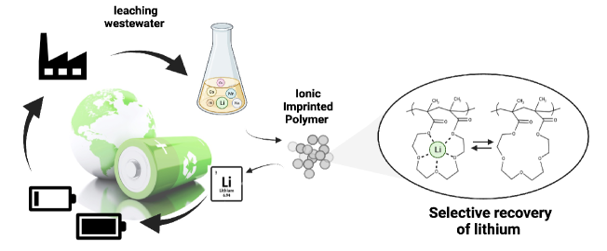Valentina Testa
- SCIENZE CHIMICHE E DEI MATERIALI
- Phd: 37th cycle
- Department of Chemistry
- Matriculation number: 825725
- ORCID: orcid.org/0000-0002-8976-9160

Phd thesis
Ion-imprinted polymers as a sustainable strategy for the efficient recovery of lithium ions from dilute solutions
Lithium Ion Batteries (LIB) are one of the most popular types of rechargeable batteries. Featuring low weight, high energy density, no memory effect, and low self-discharge, they can be configured to provide both low power for extended intervals and high power for short intervals. For these reasons, LIBs are the most commonly used rechargeable batteries, finding wide applications both in consumer electronic devices and in medical devices and portable industrial tools. The technologies currently available for the recovery of lithium from spent LIBs are essentially based on hydrometallurgical processes. This method seems to be energy-intensive, time-consuming, and inefficient. Based on the foregoing, it is therefore of great interest to develop efficient and sustainable methods for the recovery of lithium from the leaching waters of spent LIBs. The purpose of this project therefore concerns the development of polymers for the selective extraction of lithium ions from diluted solutions using the ion imprinting technique.
The ion imprinting technique refers to an approach to the preparation of macroporous and highly cross-linking polymeric materials characterized by having selective binding properties towards one or more ions. This selectivity is acquired by introducing the target ion (imprinting ion) during the polymerization process. The complexation interaction between the ion and one or more functional monomers induces the formation of nanocavities complementary to the ion itself in the polymer matrix. These cavities therefore form binding sites with thermodynamic and kinetic properties typical of reversible and selective ionic bonds.
In the case of lithium ion, we want to exploit the complexing capacity towards the ion of some functional monomers based on oligoethylene glycol (polyethylene glycol 200/600 bisacrylates / bismethacrylates). In the presence of ions of the elements of group I A, these functional monomers are known to form covalently stable corona pseudo-ethers within the polymer matrix. It has recently been shown in the literature that this phenomenon can be used to obtain polymeric materials characterized by binding properties towards lithium ion.
The research project has been co-financed by the PON D.M. 1061 scholarship in collaboration with Sea Marconi Technologies.





